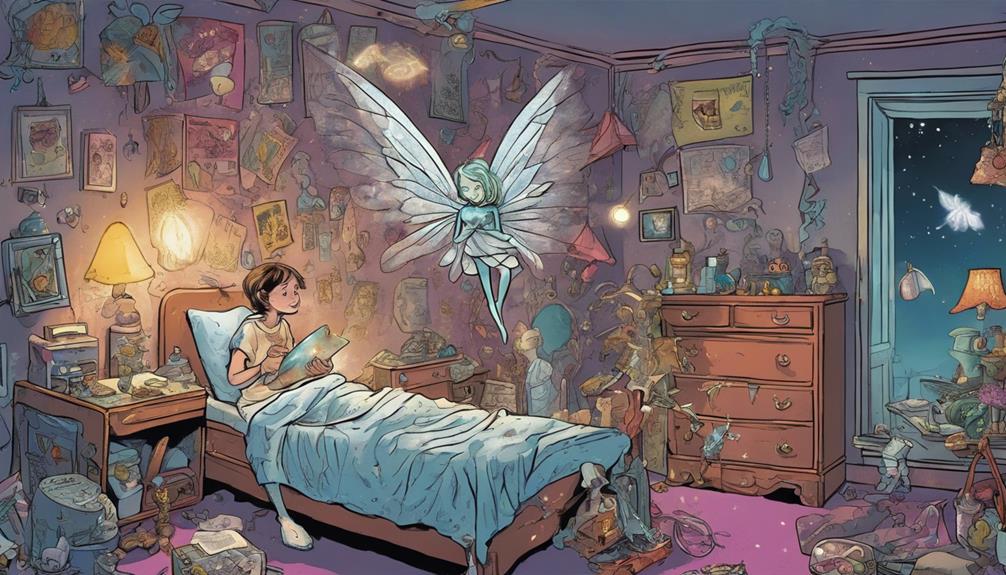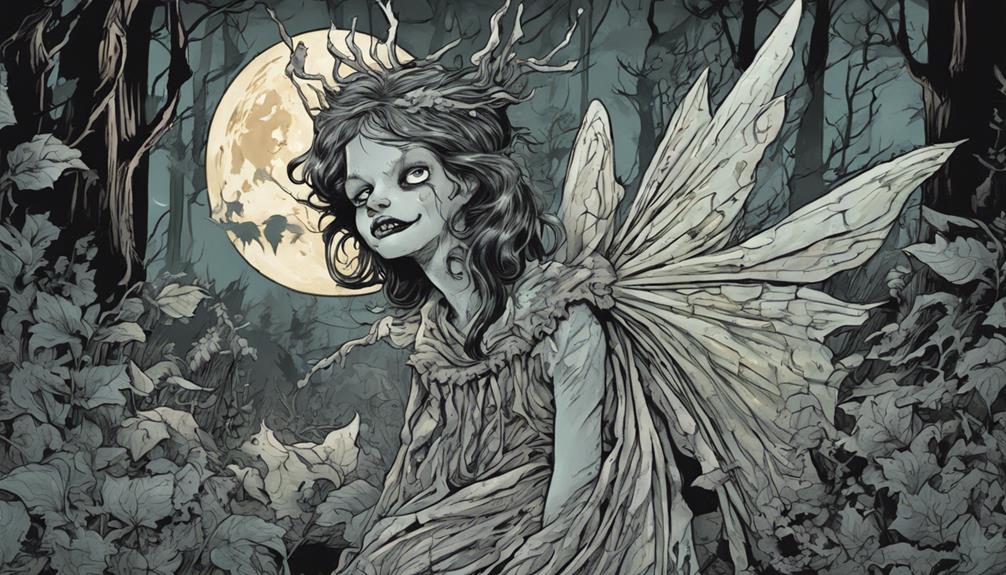The Tooth Fairy faces a host of challenges that can dampen her magical appeal. You see, parents worry about materialism as payouts for lost teeth increase. They also struggle to balance maintaining the enchantment with their children's growing skepticism. Different cultures have their own unique practices, adding complexity to her job. Technological changes, like digital payments, impact how kids engage with the tradition. Plus, parents play a pivotal role, maneuvering their own expectations and beliefs. Through it all, the Tooth Fairy must find ways to preserve the wonder of the experience. Discover how she manages these hurdles and more! The Tooth Fairy must also navigate the challenges of modern parenting, where concerns over sugar intake and dental health can overshadow the excitement of a lost tooth. With the rise of social media, the pressure to create picture-perfect moments can detract from the genuine enchantment of the tradition. Despite these obstacles, the Tooth Fairy remains a beloved and enduring figure in many childhoods, continuing to sprinkle her magic and preserve the wonder of the experience. Discover how she manages these hurdles and more in ‘the truth about tooth fairy‘.
Key Takeaways
- Rising materialism concerns lead parents to question monetary rewards for lost teeth, affecting the Tooth Fairy's traditional role.
- Balancing the magic of the Tooth Fairy with increasing skepticism complicates maintaining childhood wonder and trust.
- Cultural variations in tooth exchange practices create diverse expectations and experiences surrounding the Tooth Fairy tradition.
- The influence of technology, including virtual apps and social media, shifts focus from magical experiences to monetary exchanges.
Evolving Perceptions of Materialism

As parents navigate the Tooth Fairy tradition, they're increasingly concerned that giving money for lost teeth might encourage materialism in their children. With the average payout reaching $5.84 in 2024, many worry that this financial reward could lead kids to expect monetary compensation for other milestones. You might find yourself questioning whether this trend fosters a transactional view of childhood, where experiences like losing a tooth become just another opportunity for a cash reward.
Debates are brewing among parents about the appropriateness of financial incentives for natural occurrences. Some opt for non-monetary rewards, like small gifts or experiences, to help instill values beyond materialism. By choosing these alternatives, you can emphasize the significance of memories and learning over cash value.
Surveys show that over 56% of parents forget to leave money for the Tooth Fairy, which might affect children's understanding of reliability and the worth of money. As you consider your approach, reflecting on how you want to shape your child's perception of value can be vital.
Ultimately, striking a balance can help you navigate the complexities of this beloved tradition without promoting materialistic attitudes.
Balancing Magic and Reality

Steering through the intersection of childhood wonder and emerging skepticism about the Tooth Fairy can be a tricky endeavor for parents. You want to keep the enchantment of the Tooth Fairy tradition alive while also fostering trust and transparency. As your child approaches ages 7-8, they'll likely start questioning the Tooth Fairy's existence, prompting conversations about belief and honesty that can feel intimidating.
Many parents today lean toward honest parenting, which complicates the magic of the Tooth Fairy. You must balance the emotional impact of this myth; losing the Tooth Fairy can signify a painful shift from innocence to skepticism. It's vital to navigate these conversations delicately, ensuring your child feels secure and supported.
Additionally, the cultural significance of the Tooth Fairy varies globally, adding another layer of complexity. Different customs, like Ratoncito Pérez in Spain or La Petite Souris in France, highlight the unique challenges of maintaining these traditions.
Furthermore, the increasing financial aspects tied to the tradition, such as average payouts for lost teeth, can further complicate the experience, blending monetary rewards with childhood magic.
Ultimately, finding harmony between magic and reality is critical for preserving the joy of this cherished tradition.
Encouraging Belief Amid Skepticism

As your child starts to question the Tooth Fairy, it's essential to nurture their imagination and wonder.
You can address their doubts while balancing truth and magic, creating an environment where creativity thrives.
Engaging in open conversations about their questions can help maintain the enchantment of this beloved tradition.
Nurturing Imagination and Wonder
Nurturing imagination and wonder in children not only sparks their creativity but also helps maintain the magic of childhood amid growing skepticism. The Tooth Fairy tradition plays an essential role in this process, transforming the experience of losing baby teeth into a rite of passage that strengthens emotional connections between you and your child.
As they enthusiastically await the arrival of the Tooth Fairy, children engage in magical thinking, which peaks between ages 3 and 8. You face the challenge of preserving this belief even as your child starts to question the Tooth Fairy's existence. Balancing the need for honesty with the desire to keep the magic alive is crucial.
Encouraging their belief in the Tooth Fairy can cultivate a sense of wonder, allowing them to appreciate the fantastical aspects of life that contribute to their emotional well-being. Through conversations about the Tooth Fairy, you can celebrate these magical moments while gently guiding your child toward understanding life's realities.
This approach not only nurtures their imagination but also strengthens family bonds, creating lasting memories that your child will cherish as they grow.
Addressing Questions and Doubts
Children often start to question the Tooth Fairy's existence around ages 7 to 8, leaving you to navigate their skepticism while keeping the magic alive. It's essential to address their doubts thoughtfully, as belief in the Tooth Fairy can greatly enrich their childhood experience.
Here are three ways you can encourage their imagination while discussing lost teeth:
- Share Stories: Tell tales about the Tooth Fairy's adventures, emphasizing how she helps children celebrate their lost teeth. This can spark curiosity and excitement.
- Create a Ritual: Establish a special routine for when they lose a tooth. Perhaps leave a note or a small surprise alongside the tooth, reinforcing the magic of the moment.
- Encourage Questions: Invite your child to express their thoughts. Engage in a thoughtful conversation about trust and belief, allowing them to explore their feelings about the Tooth Fairy.
Balancing Truth and Magic
Steering the delicate balance between truth and magic often challenges parents when fostering their child's belief in the Tooth Fairy amid growing skepticism. As your child approaches the age of 7 or 8, they might start questioning the existence of the Tooth Fairy, especially after losing a tooth. You face a dilemma: should you maintain the enchanting myth or promote honesty?
Engaging in conversations about the Tooth Fairy can help you navigate this tricky terrain. These discussions not only allow you to explore imagination and creativity but also strengthen your emotional bond with your child. Sharing stories about the Tooth Fairy can create cherished memories, marking this milestone in their developmental journey.
However, it's crucial to reflect on your family's values. Some parents choose to uphold the Tooth Fairy tradition to preserve childhood innocence, while others emphasize transparency and trust. By fostering an environment where questioning is welcomed, you can encourage your child to express their thoughts and feelings.
Ultimately, balancing truth and magic requires sensitivity. As your child shifts from belief to skepticism, guiding them through this journey can help maintain the wonder of childhood while promoting honesty in your relationship.
Cultural Variations in Practices

You might be surprised to learn how different cultures handle lost teeth, each with its own unique customs.
From Ratoncito Pérez in Spain to tossing teeth on roofs in Japan, these traditions reflect local beliefs and values.
Economic factors also play a role, influencing how much children receive in exchange for their teeth around the world.
Global Tooth Exchange Traditions
Around the world, different cultures have their own unique traditions for exchanging lost teeth, each reflecting a blend of beliefs and customs. You'll find that these practices not only celebrate the loss of a tooth but also symbolize hopes for the child's future.
In Spain, children place their lost teeth under their pillows for Ratoncito Pérez, a mouse that brings gifts or money in exchange.
In Japan, kids throw their lower teeth onto the roof and their upper teeth into the ground, believing this will promote straight growth of their new teeth.
In South Africa, children place lost teeth in a slipper for a magical mouse, showcasing a local twist on the tooth fairy story.
These traditions highlight the diverse ways cultures approach the milestone of losing a tooth. While the Tooth Fairy might be a common figure in some places, others have different characters or rituals that bring joy and hope during this change.
Each tradition carries its significance, ensuring that the experience of losing a tooth is memorable and meaningful for children everywhere.
Unique Cultural Customs
Unique cultural customs surrounding the loss of teeth reveal a rich tapestry of practices that celebrate this milestone in diverse and meaningful ways. As you explore these traditions, you'll see how different cultures bring their unique flair to the experience of losing teeth.
Here's a quick overview of some fascinating customs:
| Country | Custom Description |
|---|---|
| Spain | Children place lost teeth under their pillows for Ratoncito Pérez, who exchanges them for money or small gifts. |
| Japan | Kids throw lost teeth onto rooftops to encourage straight growth for their new teeth. |
| South Africa | A tradition involves placing lost teeth in a slipper for a magical mouse to leave a gift. |
| Middle East | Children throw their teeth to the sky, symbolizing wishes for good fortune and strong new teeth. |
| Greece | It's customary to throw lost teeth onto roofs for a pig, believed to bring good luck. |
These unique customs emphasize how losing teeth is not just a personal milestone but a cultural celebration that varies greatly around the world. You'll find that each tradition carries its own charm and significance.
Economic Influences on Practices
Economic factors play a considerable role in shaping how different cultures approach the Tooth Fairy tradition, resulting in varied practices and monetary rewards across the globe. For instance, the average payment for a lost tooth in the US is around $5.84, influenced by inflation and peer pressure. In contrast, in the UK, Tooth Fairys typically leave about £1.80 per tooth. These regional differences highlight the economic influences on this whimsical tradition.
Here are three key influences on Tooth Fairy practices:
- Socio-economic status: Families often adjust their payouts based on their financial situation, leading to diverse values placed on lost teeth.
- Cultural norms: Different cultures have varying expectations regarding how much to reward children for their lost teeth, affecting overall practices.
- Historical trends: Over the decades, the value of teeth has considerably risen, reflecting changing economic conditions, from dimes in the 1940s to several dollars today.
As parents navigate these economic influences, they often feel pressured to maintain consistency in Tooth Fairy payouts, ensuring their children perceive value in this magical exchange.
Economic Challenges and Expectations

Steering today's economy, the Tooth Fairy faces significant challenges in meeting children's expectations while balancing varying family financial situations. When your child loses their first lost tooth, excitement builds, and many kids anticipate a bigger reward, often influenced by friends who may have received more. In 2024, the average payout reached $5.84, but this amount doesn't reflect the economic disparities among families. Parents in different socio-economic brackets often adjust their rewards based on what they can afford, creating inconsistent experiences for children.
Moreover, over 56% of parents admit to occasionally forgetting to make payments, which adds another layer of complexity for the Tooth Fairy. Children may feel disappointed when their expectations aren't met, leading to questions about the magic surrounding this tradition.
As the Tooth Fairy navigates these economic challenges, she must also adapt to modern expectations, with some parents debating whether financial rewards are appropriate for a natural part of childhood development. Balancing the desire to maintain the magic of the Tooth Fairy while addressing these economic realities is a continuous challenge, one that requires creativity and empathy.
The Role of Parents in Tradition

Parents shape the Tooth Fairy tradition by deciding not only how much to leave under pillows but also how they want to communicate the magic and meaning behind it. As you navigate this whimsical journey, consider these factors that influence the experience for your child:
- Celebrating Milestones: The first lost baby tooth often earns a higher reward, reflecting your desire to mark this significant moment. This celebration can vary based on your family values and financial circumstances.
- Balancing Belief and Honesty: You might face the challenge of maintaining the magic while fostering trust. Conversations about the Tooth Fairy can lead to deeper emotional connections and help your child understand the value of honesty.
- Teaching Financial Literacy: The tradition also serves as a platform for discussing money. Some parents choose non-monetary rewards, demonstrating lessons about the importance of experiences over materialism, allowing your child to grasp the concept of value.
Navigating Technology's Influence

In today's tech-driven world, children are experiencing the Tooth Fairy tradition in ways that are both exciting and challenging, as digital tools reshape how they engage with this beloved myth. Many kids now use virtual Tooth Fairy apps, which can overshadow the charm of leaving a physical tooth under a pillow.
Instead of a simple exchange, parents document the tooth loss experience on social media, creating a performance culture that shifts focus away from the magic of the Tooth Fairy. With customizable digital letters and online resources at their disposal, parents can enhance the experience, but this also diminishes the mystery surrounding the Tooth Fairy's visits.
Additionally, the rise of digital payments has changed how families handle the exchange; instead of cash, many now opt for instant transfers, aligning with a tech-savvy generation. Economic trends influenced by technology mean parents frequently check online to see the current average payouts for lost teeth, adjusting their rewards accordingly.
While these advancements offer convenience, they also challenge the traditional essence of the Tooth Fairy, making it essential to strike a balance between embracing technology and preserving the enchanting experience.
Preserving Childhood Wonder

Preserving childhood wonder hinges on nurturing the magic of traditions like the Tooth Fairy, which spark imagination and joy in young minds. This tradition encourages children to engage in magical thinking, especially when they lose an upper tooth.
Here are three key ways to maintain this enchantment:
- Create Personalized Rituals: Celebrate the Tooth Fairy by leaving notes, making a special tooth fairy house, or setting up a unique exchange. These rituals enhance the experience and deepen family connections.
- Foster Creativity and Imagination: When children believe in the Tooth Fairy, they learn to explore concepts of wonder and joy, essential for their emotional and cognitive development. This imaginative play helps them make sense of unexplainable events.
- Encourage Conversations: Discussing the Tooth Fairy can strengthen the bond between parents and children. It allows for a balance between preserving the magic and gently shifting to the truth as kids grow older.
Frequently Asked Questions
What Is the Tooth Fairy's Weakness?
The Tooth Fairy's weakness is maintaining children's belief as they grow older. When kids start questioning magic, it can undermine the excitement and joy associated with losing a tooth, making the tradition less enchanting for them.
What Is the Dark Story Behind the Tooth Fairy?
You might find that the dark story behind the Tooth Fairy involves ancient superstitions, where teeth were linked to protection and rituals. These beliefs often reflected deeper fears surrounding loss, luck, and the unknown.
How to Explain Tooth Fairy Isn't Real?
You might worry that telling your child the Tooth Fairy isn't real will ruin the magic. Instead, frame it as a celebration of imagination, emphasizing the joy and creativity behind the tradition they'll always cherish.
What Is the Deal With the Tooth Fairy?
The Tooth Fairy's a whimsical figure who exchanges lost teeth for money, creating excitement for kids. This tradition varies globally, but it always sparks joy and imagination, making childhood memories even more magical and unforgettable.
Conclusion
Ultimately, the Tooth Fairy symbolizes the delicate balance between childhood wonder and the harsh realities of growing up.
As she flits through homes, exchanging teeth for coins, she reminds you of the magic that comes with belief.
Yet, as technology and skepticism creep in, it's up to you to nurture that spark of imagination.
By fostering traditions, you not only preserve the enchantment but also create a legacy of joy and wonder for the next generation to cherish.









